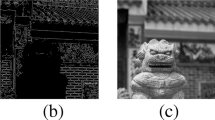Summary
The amount of light energy a particle absorbs does not depend upon correct focus. The change in the path of light rays brought about by defocusing causes absorbing areas to be registered as areas of higher transmittance than when in focus. Already wellknown in photometry, this effect is put to use by the “blind focus” method at the television texture analysis system (TAS, Leitz). Some chromophores within the object to be measured are compared to a preset value of transmittance, for exampleT=0.40.
Only the area representing the structures as dense or denser than the preset density are registered. If the structures are out of focus the size of the registered area is too low, since by defocusing, structures to be measured become pale and diffuse, the correct focus corresponds to the largest area to a preset value of transmittance.
Similar content being viewed by others
References
Bachmann, P., Hinrichsen, K.: Principles and methods for the quantitative determination of Feulgen stained DNA with the television texture analysis system (TAS). Histochemistry60, 61–69 (1979)
Bishop, R.P., Young, I.T.: The automated classification of mitotic phases for human chromosome spreads. J. Histochem. Cytochem.25, 730–740 (1977)
Brenner, J.F., Dew, B.S., Horton, B., King, T., Neurath, P.W., Selles, W.D.: An automated microscope for cytologic research. A preliminary evaluation. J. Histochem.24, 100–111 (1976)
Dew, B., King, T., Mighdoll, D.: An automatic microscope system for differential leukocyte counting. J. Histochem. Cytochem.22, 685–696 (1974)
Kendall, F.M., Wu, C.T., Giaretti, W., Nicolini, C.A.: Multiparameter geometric and densitometric analysis of the G0–G1 transition of WI-38 cells. J. Histochem. Cytochem.25, 724–729 (1977)
Merz, M., Hinrichsen, K.: Recognition of morphological features of cell nuclei using image analysis. I. The calibration of the quantimet as a densitometer. In: Practical metallography, G. Petzkow, H.E. Exner (eds.), special issue 1, pp. 38–50. Stuttgart: Dr. Riederer-Verlag 1970a
Merz, M., Hinrichsen, K.: Recognition of morphological features of cell nuclei using image analysis. II. Area representation of optical density. In: Practical metallography. G. Petzkow, H.E. Exner (eds.), special issue 1, pp. 51–62. Stuttgart: Dr. Riederer-Verlag 1970b
Nicolini, C., Giaretti, W., DeSaive, C., Kendall, F.: The G0–G1 transition of WI-38 cells. Exp. Cell. Res.106, 119–125 (1977)
Ploem, J.S., Verwoerd, N., Bonnet, J., Koper, G.: An automated microscope for quantitative cytology combining television image analysis and stage scanning microphotometry. J. Histochem. Cytochem.27, 136–143 (1979)
Pressman, N.J.: Markovian analysis of cervical cell images. J. Histochem. Cytochem.24, 138–144 (1976)
Author information
Authors and Affiliations
Rights and permissions
About this article
Cite this article
Decher, J., Bachmann, P. “Blind focusing”: An objective method for avoiding errors of focus at the television texture analysis system (TAS). Histochemistry 63, 221–226 (1979). https://doi.org/10.1007/BF00644544
Received:
Accepted:
Issue Date:
DOI: https://doi.org/10.1007/BF00644544




